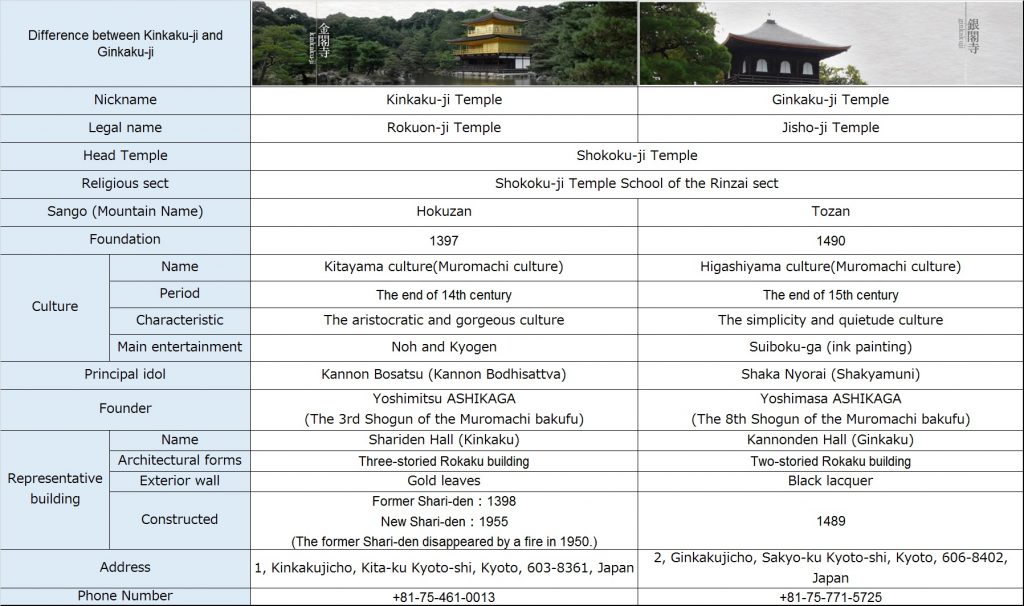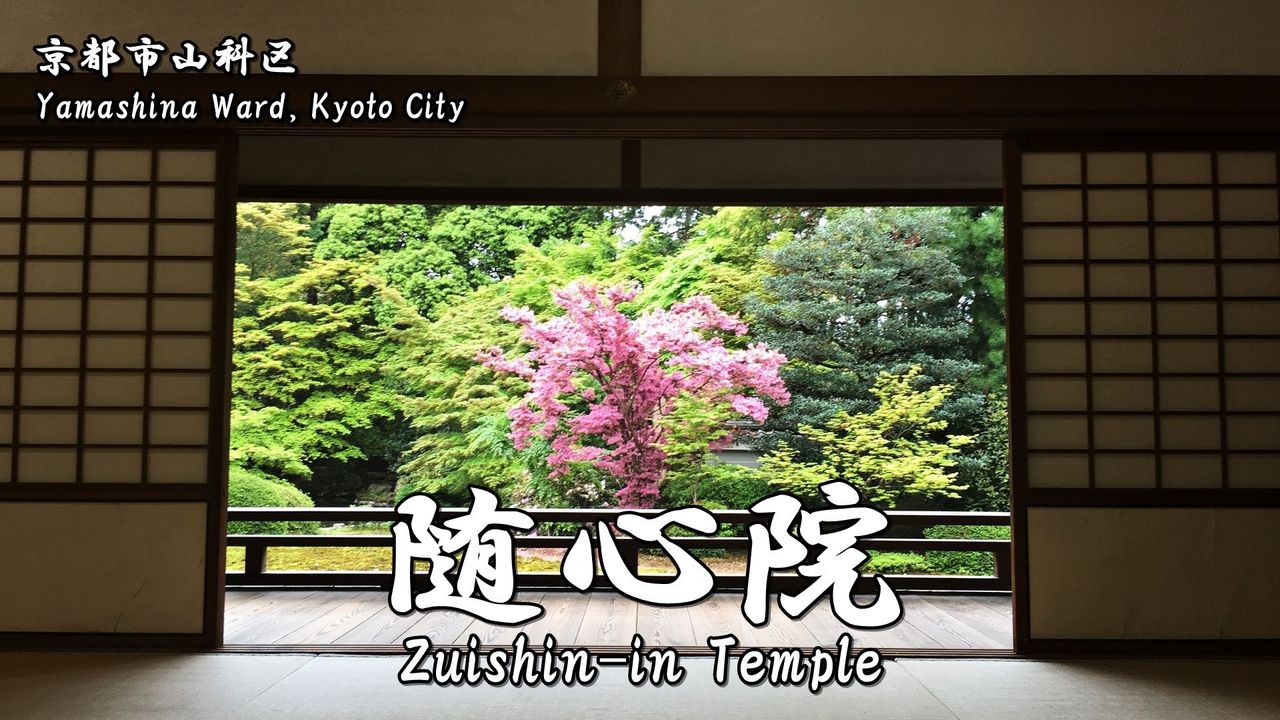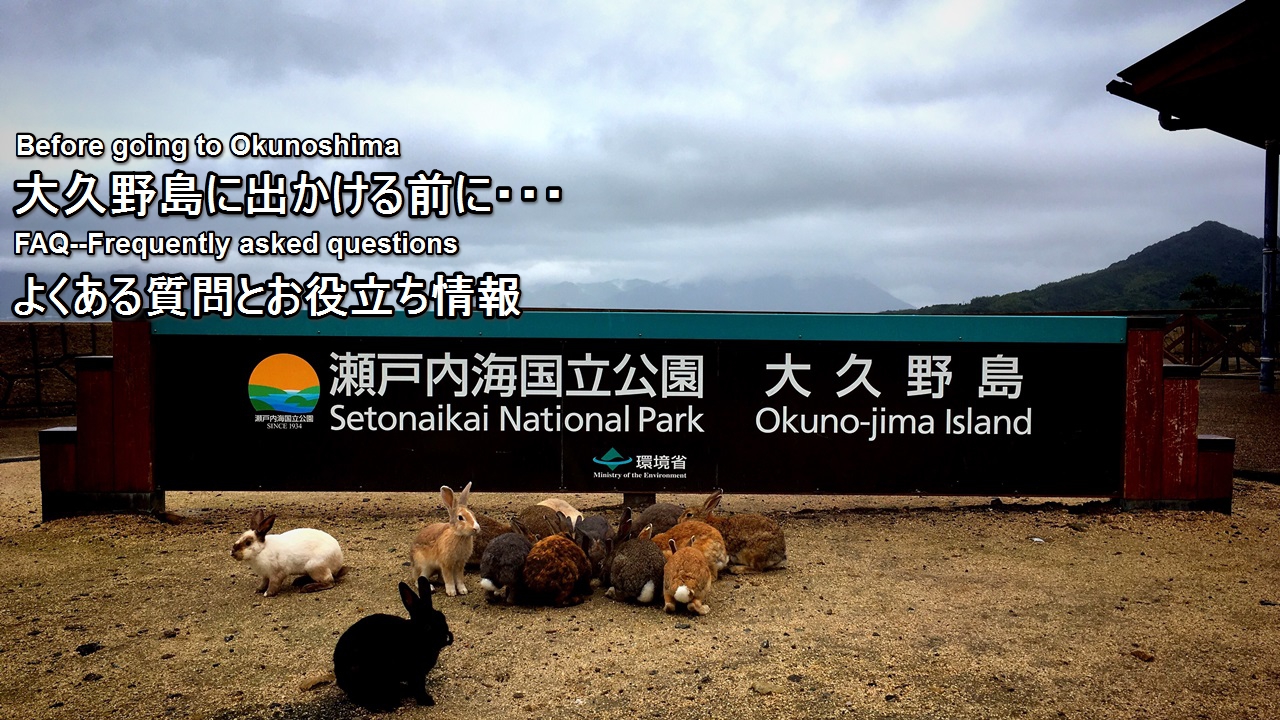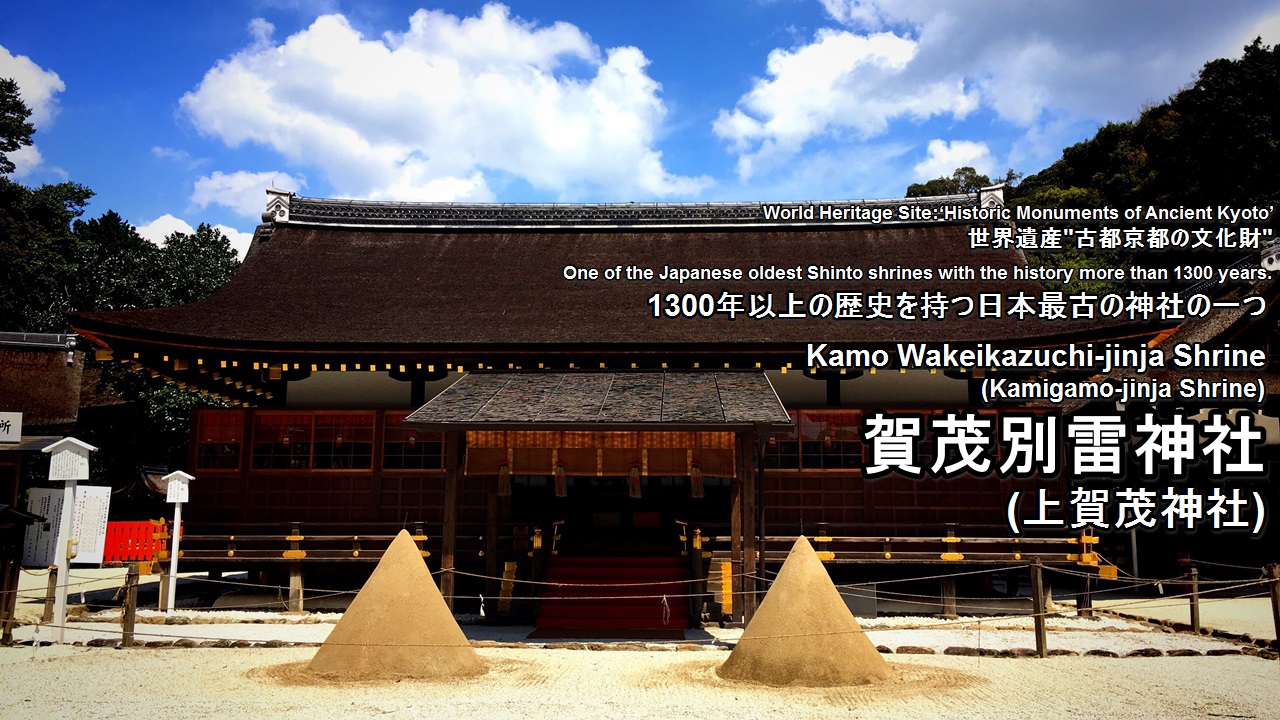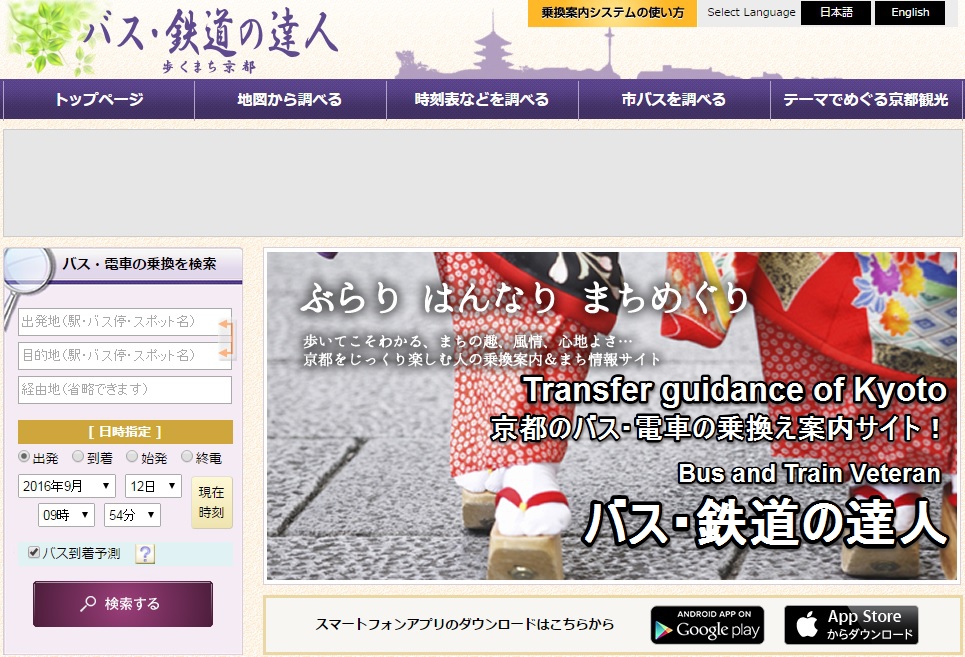Kinkaku-ji Temple (金閣寺) is a Rinzai sect Shokoku-ji School (臨済宗相国寺派) temple located in Kita Ward, Kyoto City.
This temple is a sub temple of Shokoku-ji Temple (相国寺), and the official name is Rokuon-ji Temple (鹿苑寺).
The name of Rokuon-ji (鹿苑寺) is derived from the posthumous Buddhist name of Yoshimitsu ASHIKAGA (足利義満).
(He was the 3rd Shogun (将軍) of the Ashikaga shogunate (室町幕府).
In contrast to the simple Higashiyama culture (東山文化) represented by Ginkaku (銀閣) from the 8rd Shogun Yoshimasa ASHIKAGA (足利義政), the culture of the early Muromachi period is called “Kitayama culture (北山文化)” that emphasizes gorgeousness as represented by Kinkaku.
Kinkaku-ji Temple has been designated a World Heritage Site as one of the “Historic Monuments of Ancient Kyoto (古都京都の文化財)” and the garden has been designated both a Special Historic Site and a Special Place of Scenic Beauty.
In addition, it has been designated as the Michelin green guide ★★★ (best rank).
‘If you are having trouble deciding where to go, let’s go to Kinkaku-ji Temple first of all.’
So, I went to Kinkaku-ji Temple this time.
The day when I visited this temple, it was snowy day (January 16, 2017).
Because Kinkaku-ji Temple is in the north of Kyoto, the snow is sometimes piled up here.
However, it was very rare for such a lot of snow to be piled up.
Contents:
- About World Heritage ‘Historic Monuments of Ancient Kyoto’
- Difference between Kinkaku-ji and Ginkaku-ji
- History of Kinkaku-ji Temple
- About Kinkaku-ji Temple
- Information for visitors
- Highlights of Kinkaku-ji Temple
- Photos of Kinkaku-ji Temple
- Goshuin of Kinkaku-ji Temple
- How to get to Kinkaku-ji Temple
- Hotel search & reservation around Kinkaku-ji Temple
1.About World Heritage ‘Historic Monuments of Ancient Kyoto’
17 places of temples and shrines of Kyoto are designated in the ‘Historic Monuments of Ancient Kyoto’.
↓Details of the “Historic Monuments of Ancient Kyoto” is here.↓
Kinkaku-ji Temple has been designated as the World Heritage List as part of the ‘Historic Monuments of Ancient Kyoto’.
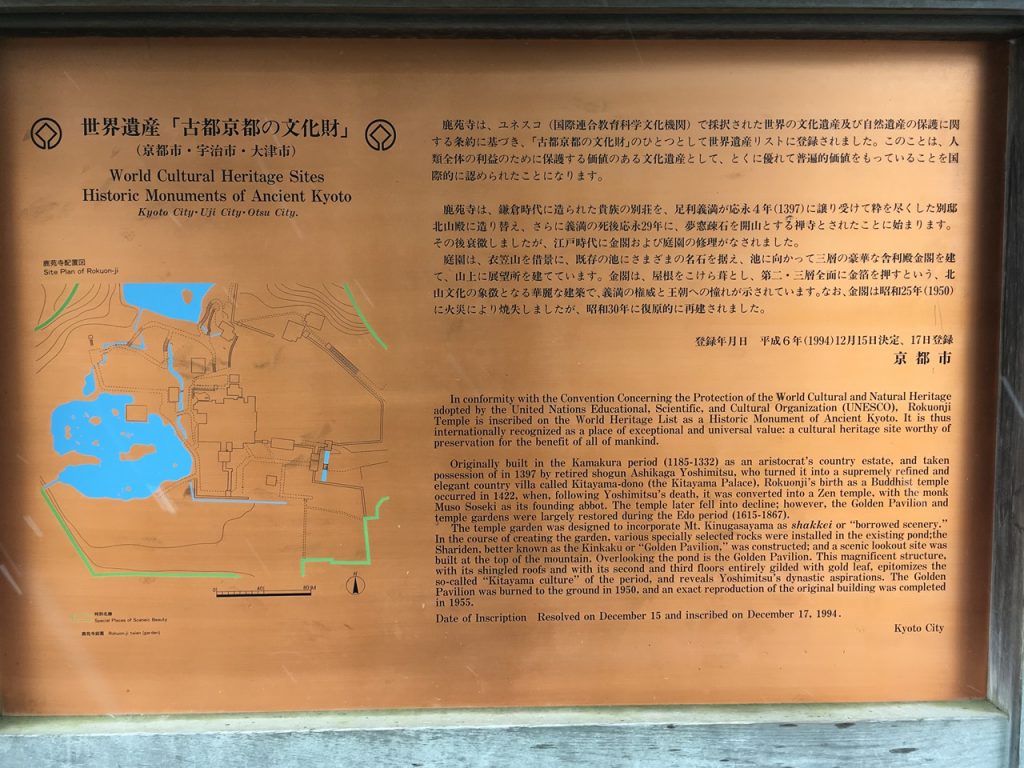
2.Difference between Kinkaku-ji and Ginkaku-ji
Both Kinkaku-ji Temple (金閣寺) and Ginkaku-ji (銀閣寺) are sub temples of Shokoku-ji Temple (相国寺).
The difference between Kinkaku-ji and Ginkaku-ji can be also called the difference between Kitayama culture (北山文化) and Higashiyama culture (東山文化).
Kitayama and Higashiyama culture are the Japanese culture that prospered in the Muromachi period (室町時代).
(Kitayama culture is the culture that prospered in the first half of the Muromachi period, and Higashiyama culture is the culture that prospered in the latter half of the Muromachi period.)
If I say difference in these culture in a word…
The Kitayama culture is gorgeous.
The Higashiyama culture is simplicity and quietude.
Why would culture change in the first half and the latter half of the Muromachi period?
It was caused by the Onin War (応仁の乱).
The Onin War was a civil war that lasted from 1467 to 1477, during the Muromachi period in Japan.
And the stage of this civil war was Kyoto.
Therefore Kyoto suffered crushing damage in this war.
Therefore Japanese culture was changed before and after Onin War.
I summarized these differences in a list.
Please refer to it if interested.

3.History of Kinkaku-ji Temple
Let’s study the history of this castle with me before introducing Kinkaku-ji Temple.
I think that we can enjoy the sightseeing of Kinkaku-ji Temple more by learning the history of this temple.(○´艸`)
Now, there are no buildings which were designated as national treasures or important cultural properties in Kinkaku-ji.
Kinkaku (金閣) that is the golden building is not a national treasure, too.
Why is it?
There are the following reasons for this.
Originally, Kinkaku-ji Temple was built in 1397 of the Muromachi period by Yoshimitsu ASHIKAGA (足利義満).
And the Kinkaku (金閣) had formerly been designated a national treasure since before the World War II but in 1950 the pavilion was burned down (金閣寺放火事件:The Kinkaku-ji Temple Arson Incident) in an act of arson committed by a monk.
And, as for the Kinkaku, the designation of the national treasure was canceled for this incident.
Later, some literary works on the theme of this case, including “Kinkaku-ji Temple (金閣寺)” by Yukio MISHIMA (三島由紀夫) and “Gobancho-yugiriro (五番町夕霧楼:Evening mist Tower of the Fifth Town)” by Tsutomu MINAKAMI (水上勉), were produced.
Afterwards, Kinkaku was rebuilt in 1955.
Therefore, the current Kinkaku is the second generation.
4.About Kinkaku-ji Temple
Kinkaku-ji (金閣寺, literally “Temple of the Golden Pavilion”), officially named Rokuon-ji (鹿苑寺, literally “Deer Garden Temple”), is a Zen Buddhist temple in Kyoto, Japan. It is one of the most popular buildings in Japan, attracting a large number of visitors annually. It is designated as a National Special Historic Site and a National Special Landscape, and it is one of 17 locations making up the Historic Monuments of Ancient Kyoto which are World Heritage Sites.
引用(citation):https://en.wikipedia.org/wiki/Kinkaku-ji
Open:9:00~17:00
Admission Fee:400 yen(High school student or older), 300 yen(Elementary / Junior high school student)
Address:1, Kinkakujicho, Kita-ku Kyoto-shi, Kyoto, 603-8361, Japan
Phone Number:+81-75-461-0013
Foundation:1397
Founder:Yoshimitsu ASHIKAGA (足利義満)
Sect:Rinzai sect Shokoku-ji School (臨済宗相国寺派)
Proncipal image:Kannon Bosatsu (観音菩薩:Guanyin)
Kinkaku-ji Temple (金閣寺) is a Rinzai sect Shokoku-ji School (臨済宗相国寺派) temple located in Kita Ward, Kyoto City.
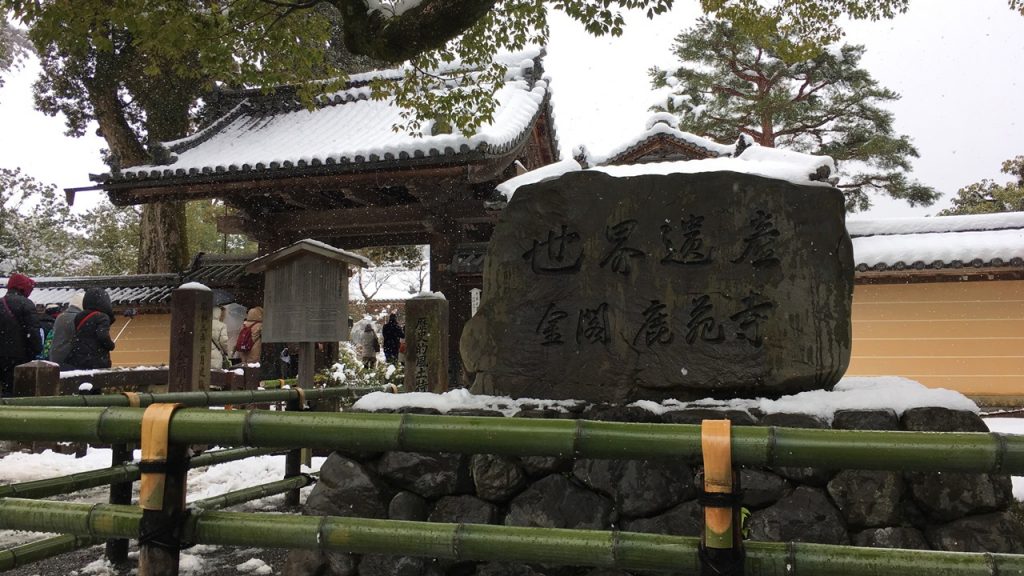
This temple is a sub temple of Shokoku-ji Temple (相国寺), and the official name is Rokuon-ji Temple (鹿苑寺).

Kinkaku-ji Temple has been designated a World Heritage Site as one of the “Historic Monuments of Ancient Kyoto (古都京都の文化財)” and the garden has been designated both a
Special Historic Site and a Special Place of Scenic Beauty.
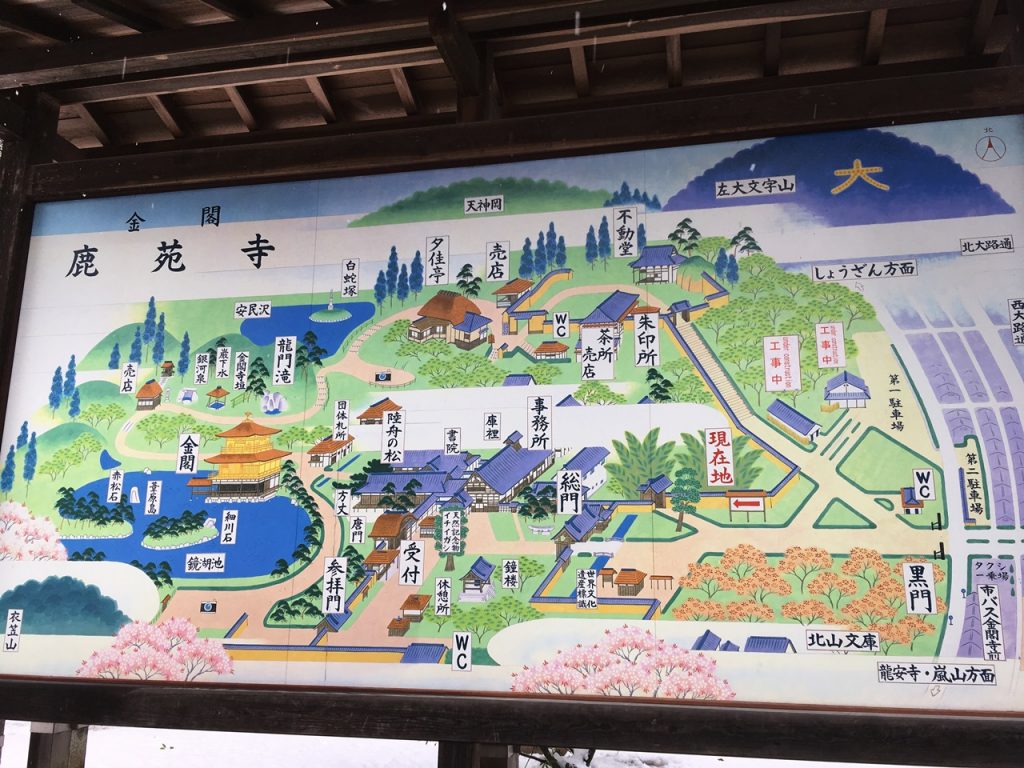
Because Kinkaku-ji Temple is in the north of Kyoto, the snow is sometimes piled up here.
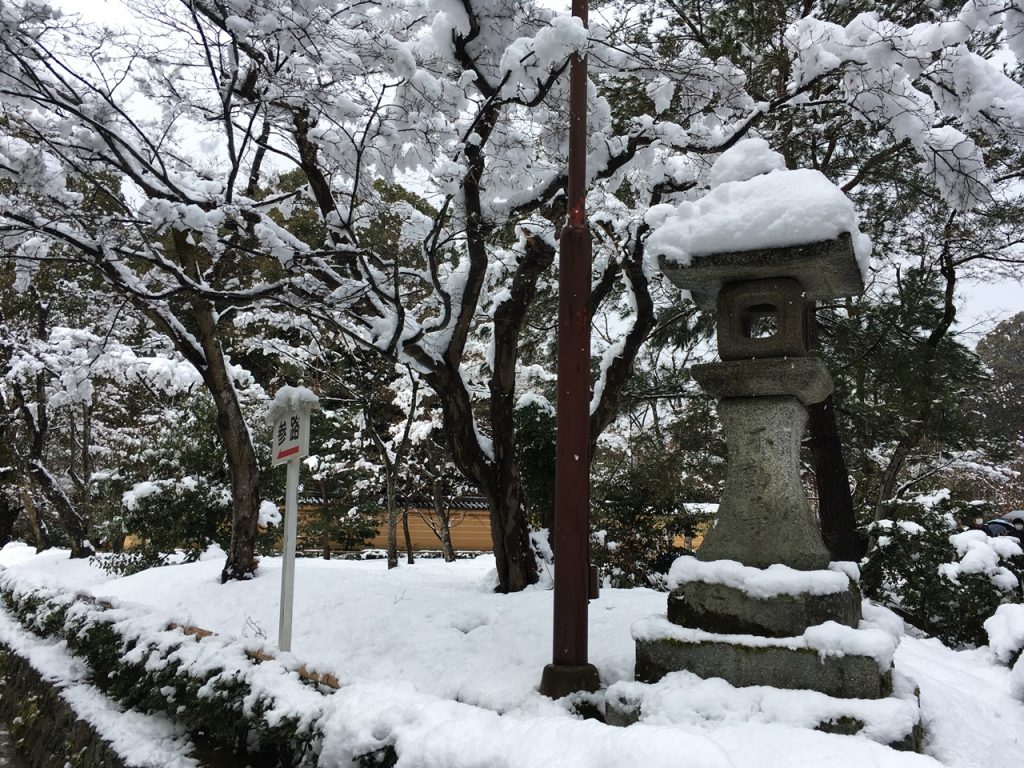
An admission fee is 400 yen (Adult).
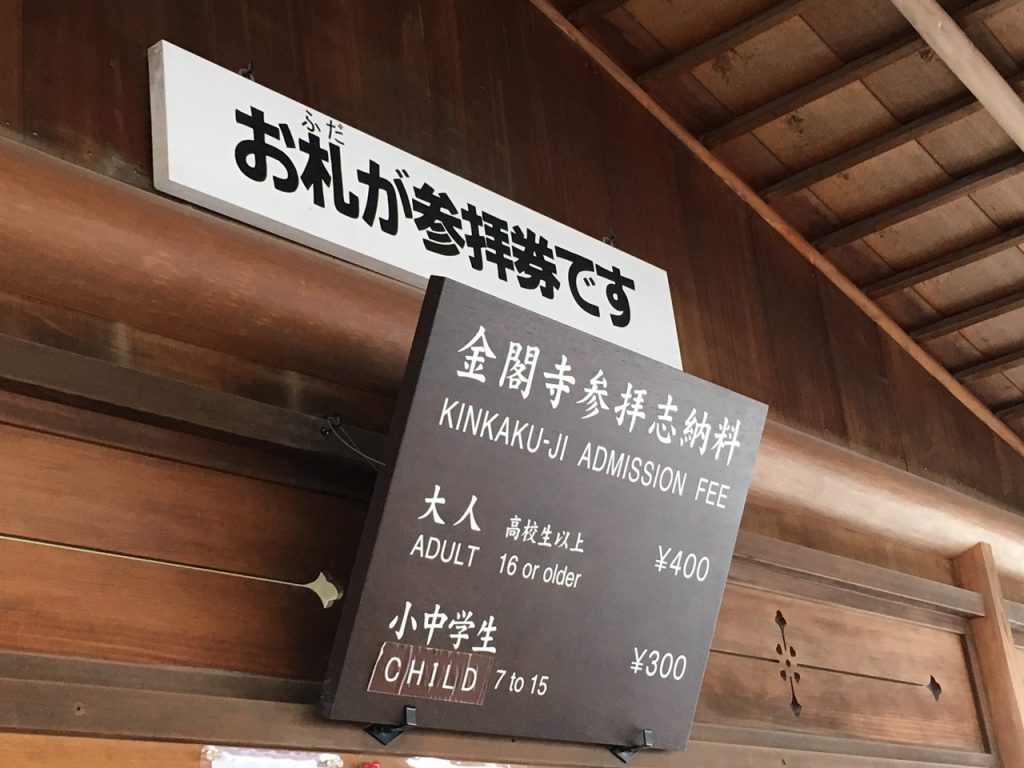
Next, let’s see the highlight of Kinkaku-ji Temple!!
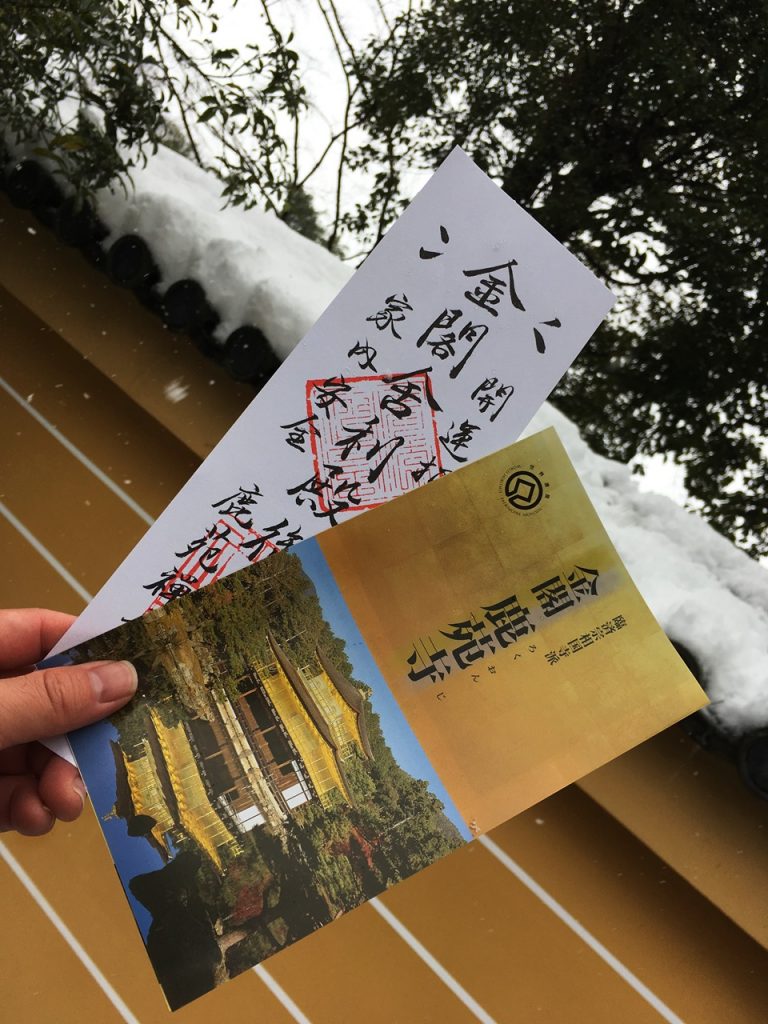
5.Information for visitors
・Because it is located away from the train station, it is inconvenient to get to the Kinkaku-ji Temple. Let’s use a bus or a taxi.
・The precincts of the temple are one-way traffic basically.
Let’s follow a rule.
6.Highlights of Kinkaku-ji Temple
- 総門:So-mon gate (Main gate)
- 鐘楼:Shoro (bell tower)
- 庫裏:Kuri (monks’ living quarters)
- 舟形石:Funakata-ishi (Ship shaped stone)
- 唐門:Kara-mon gate
- 鹿苑寺庭園(特別史跡/名勝)*:Rokuon-ji Temple Garden(Special Historic Site)*
- 金閣(舎利殿)*:Kinkaku (Shariden Hall)*
- 金閣 漱清*:So-sei*
- 鏡湖池*:Kyoko-chi Pond*
- 葦原島*:Ashihara Island*
- 方丈*:Hojo (Abbot’s Quarters)*
- 陸船の松*:Rikushu-no-matsu (an old pine-tree)*
- 書院*:Shoin (Study hall)*
- 銀河泉*:Ginga-sen*
- 巌下水*:Ganka-sui*
- 金閣寺垣*:Kinkaku-ji Gaki (Kinkaku-ji Temple’s fence)*
- 龍門滝*:Ryumon-no-taki*
- 安眠沢*:Anmin-taku Pond*
- 白蛇の塚*:Hakuja-no-tsuka (Pagoda of the white snake)*
- 夕佳亭*:Sekka-tei*
- 不動堂*:Fudo-do hall*
「*印」のついている見どころは有料エリアです。(This seal (*) is a pay area.)
●総門:So-mon gate (Main gate)
This is So-mon gate (Main gate) which has the role of the entrance of Kinkaku-ji.
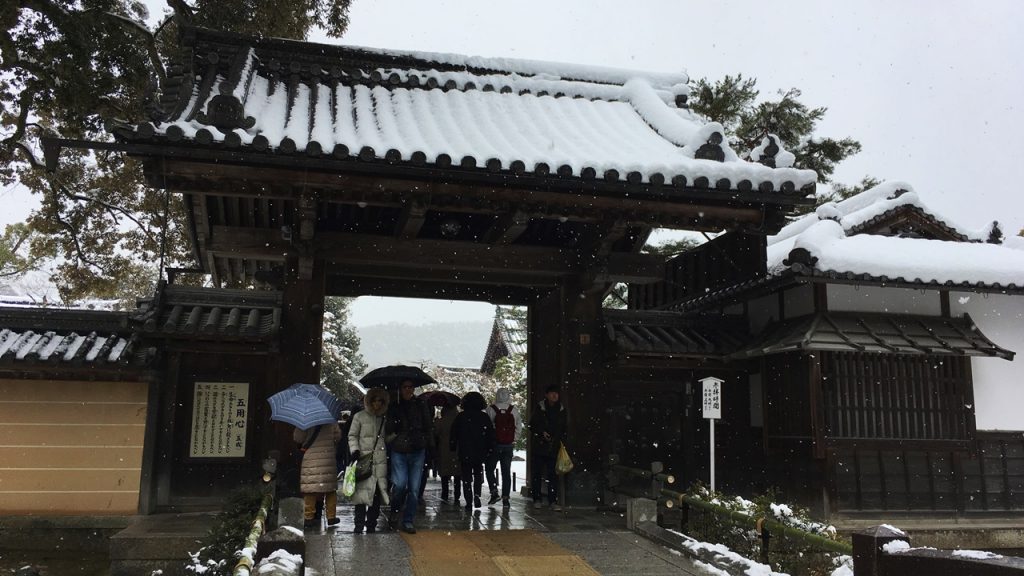
●鐘楼:Shoro (bell tower)
This is Shoro (bell tower).
The bell hung in this building was made in the Kamakura period (鎌倉時代).
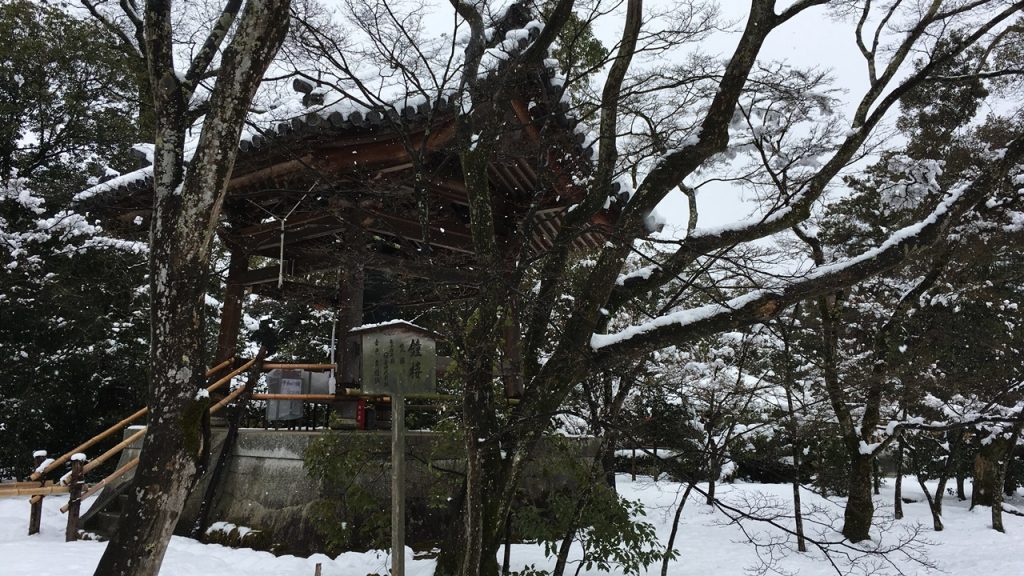
●庫裏:Kuri (monks’ living quarters)
This is Kuri (monks’ living quarters).
This building was built in 1602 of the Azuchi-Momoyama period (安土桃山時代) and was rebuilt in 1835 of the Edo period.
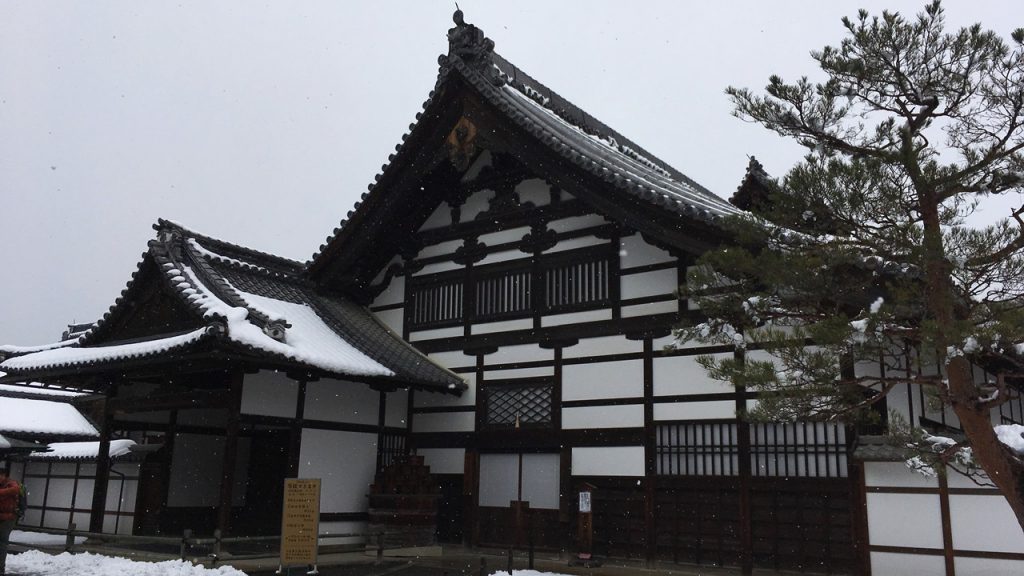
●舟形石:Funakata-ishi (Ship shaped stone)
This is a big stone in the shape of a boat called ‘Funakata-ishi (舟形石:Ship shaped stone)‘.
In the old days, this stone was used as a Chozubachi (手水鉢:Washbasin).
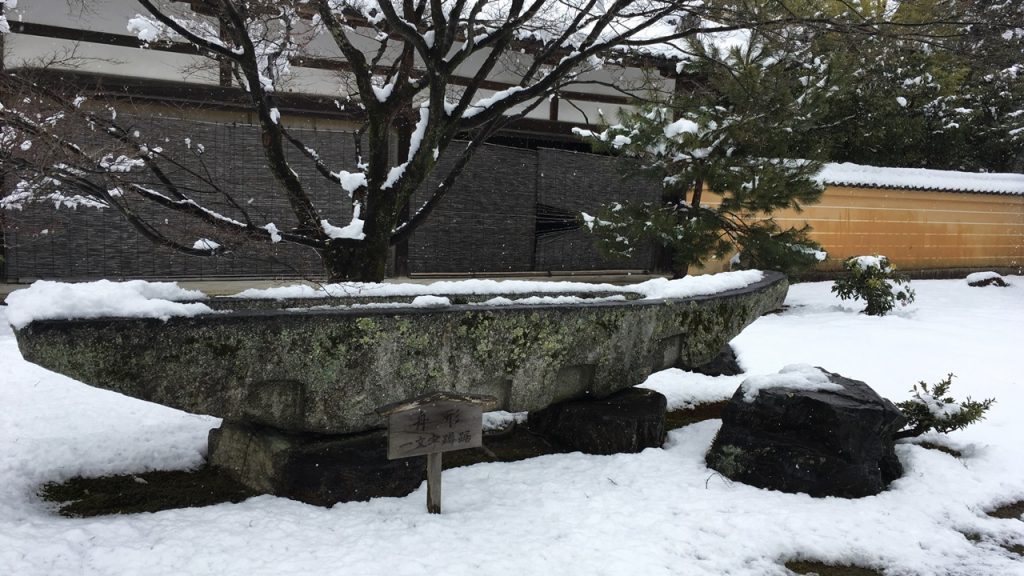
●唐門:Kara-mon gate
This is Kara-mon gate.
It was rebuilt in the Edo period.

●鹿苑寺庭園(特別史跡/名勝)*:Rokuon-ji Temple Garden(Special Historic Site)*
■YouTube:雪の金閣寺:Snowy Kinkaku-ji Temple(20170116)
This garden has been designated both a Special Historic Site and a Special Place of Scenic Beauty.
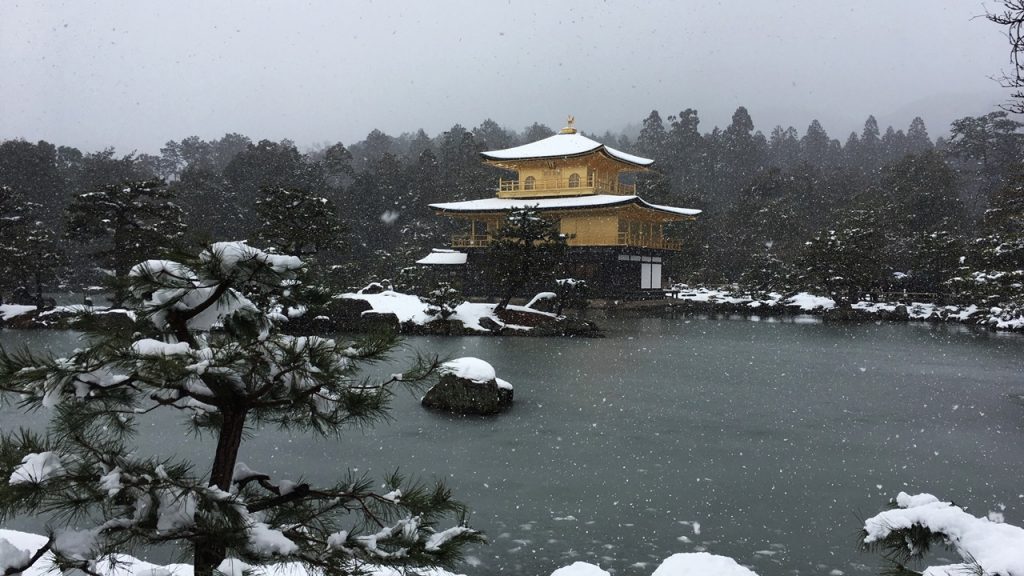
●金閣(舎利殿)*:Kinkaku (Shariden Hall)*
This is Kinkaku (commonly known as the Golden Pavilion) which was rebuilt in 1955.
It is considered to be one of the three great towers of Kyoto along with Ginkaku (Jisho-ji Temple) and Hiunkaku (Nishihongan-ji Temple).
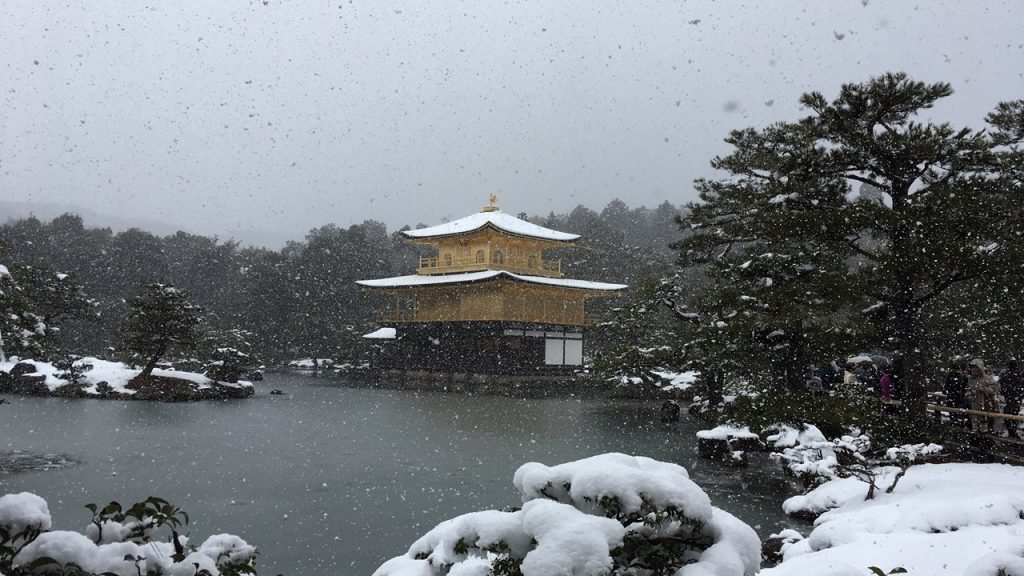
The golden phoenix which is a symbol of peace is displayed on the roof of this building.
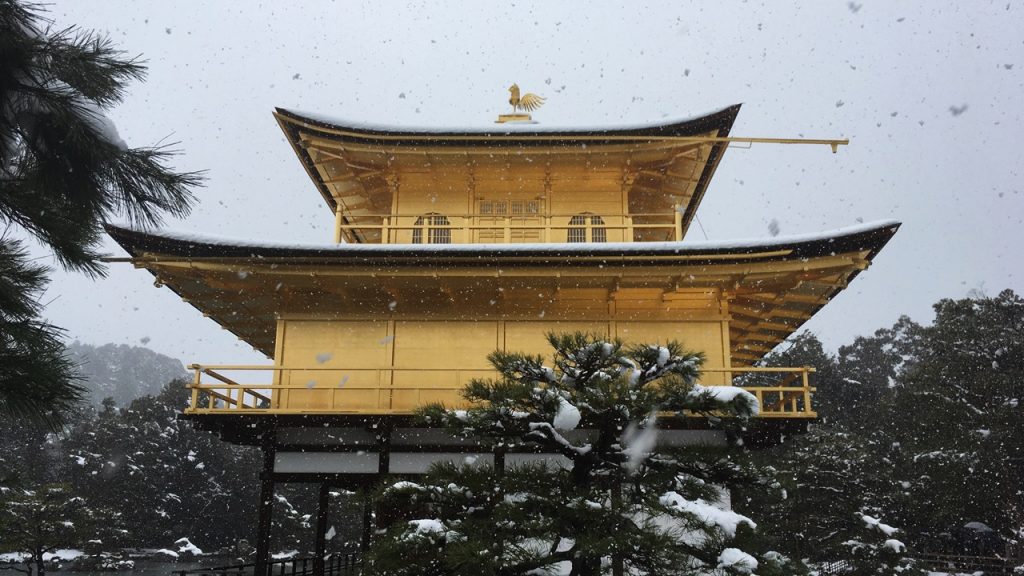
The gross weight of gold leaf attached to this building is approximately 20 kg.
The current value of it is approximately 100 million yen.
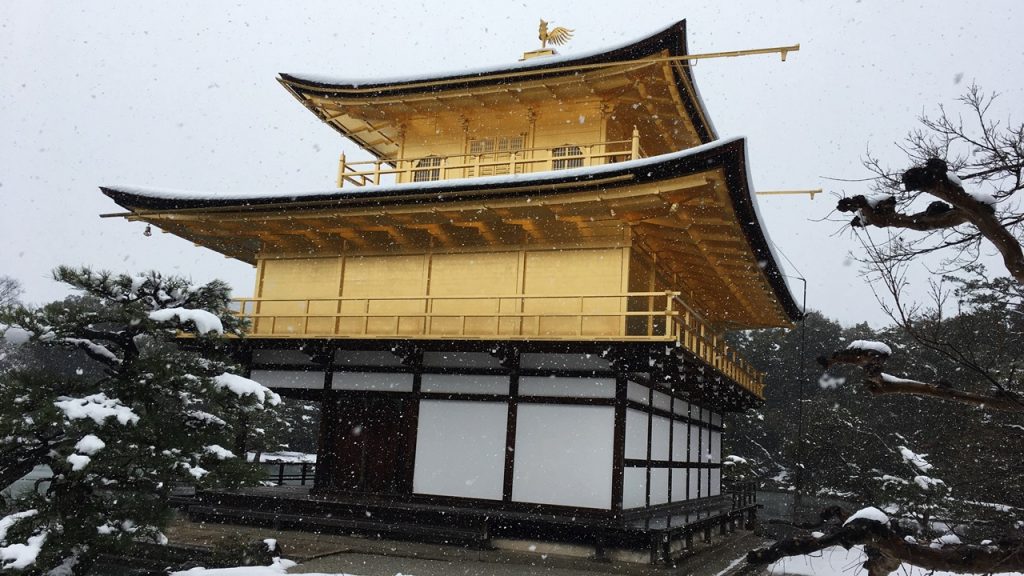
●金閣 漱清*:So-sei*
The small building which was built beside AA is called ‘So-sei‘.
This building has the role of the boat dock.
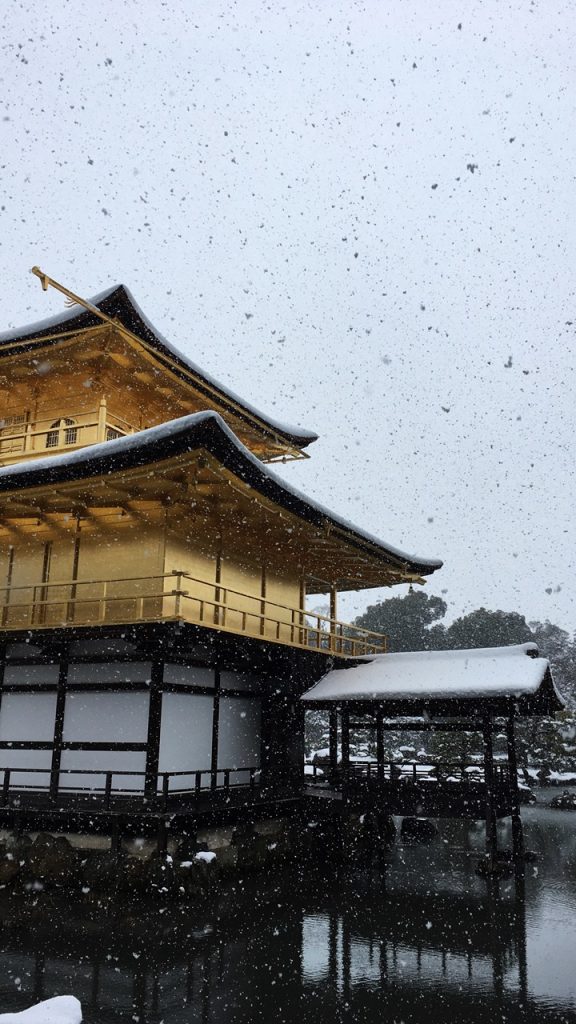
●鏡湖池*:Kyoko-chi Pond*
The pond in the front of Kinkaku is called Kyoko-chi Pond.
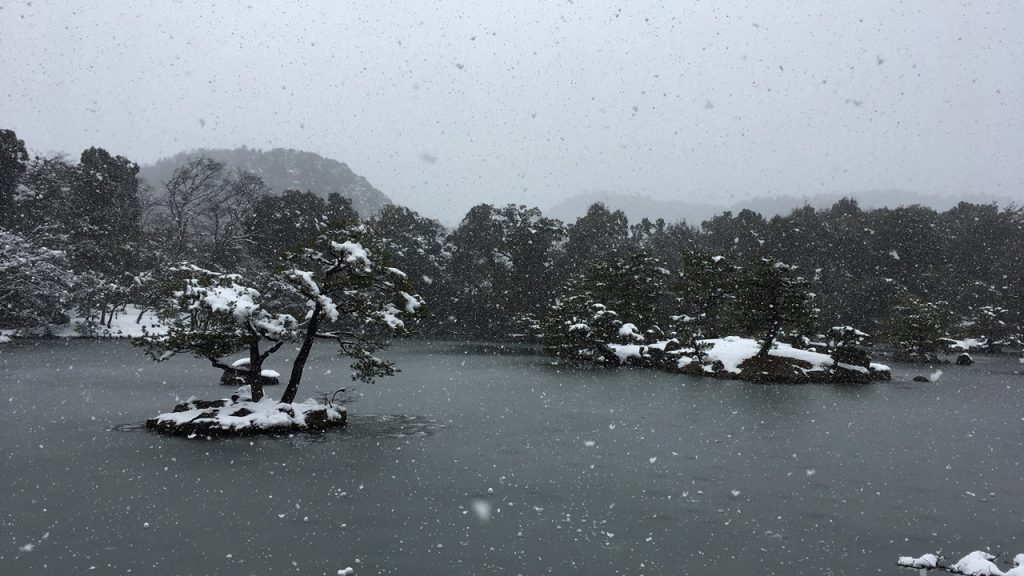
●葦原島*:Ashihara Island*
The island in the middle of the Kyoko-chi Pond is called Ashihara Island.
This island is imagining the Horai-jima island (蓬莱島) that a hermit lives.

●方丈*:Hojo (Abbot’s Quarters)*
This is Hojo (Abbot’s Quarters) which was rebuilt in 1678 of the Edo period.
This building was granted by Emperor Go-mizunoo (後水尾天皇) in the Edo period.

This building has a role as the Hon-do (Main Temple) of this temple, and the Sacred Avalokitesvara (聖観世音菩薩) which is the principal image is enshrined.
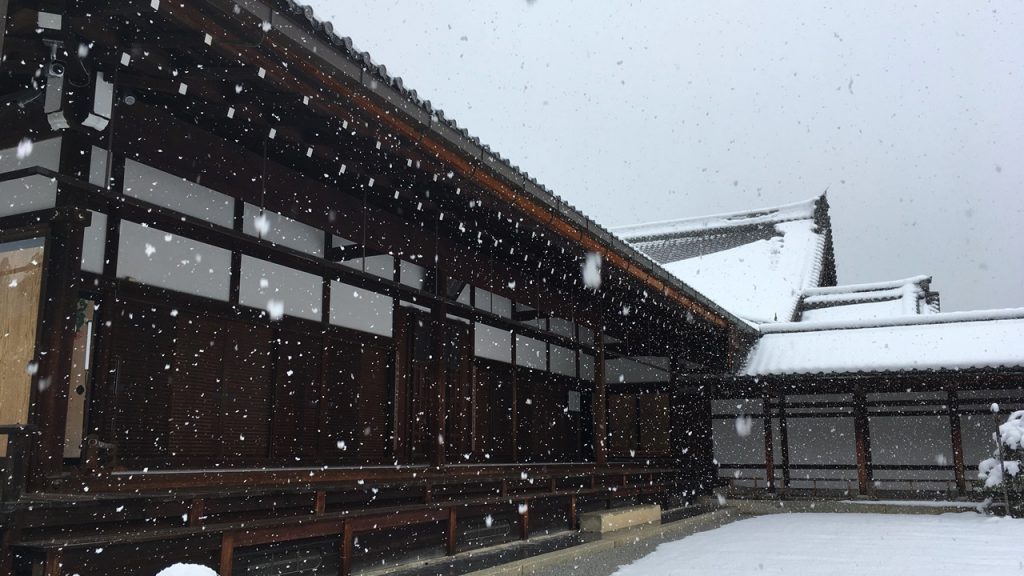
●陸舟の松*:Rikushu-no-matsu (an old pine-tree)*
The Rikushu-no-matsu (an old pine-tree) is planted in the front yard of the Hojo.
It is considered to be one of the three great pine-tree of Kyoto along with Yuryu-no-matsu (Yoshimine-dera Temple) and Goyo-no-matsu (Hosen-in Temple).
The word called ‘Rikushu (陸舟)’ has the meaning of ‘Ship of the land’.
Therefore this pine-tree has a shape of the ship.
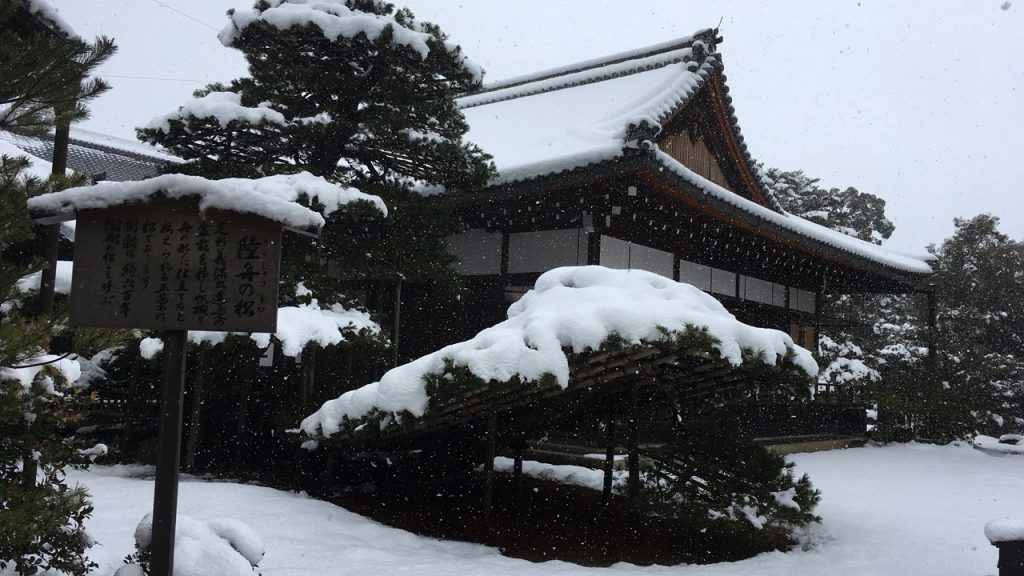
●書院*:Shoin (Study hall)*
This is the Shoin (Study hall) which was built in the north side of the Hojo.
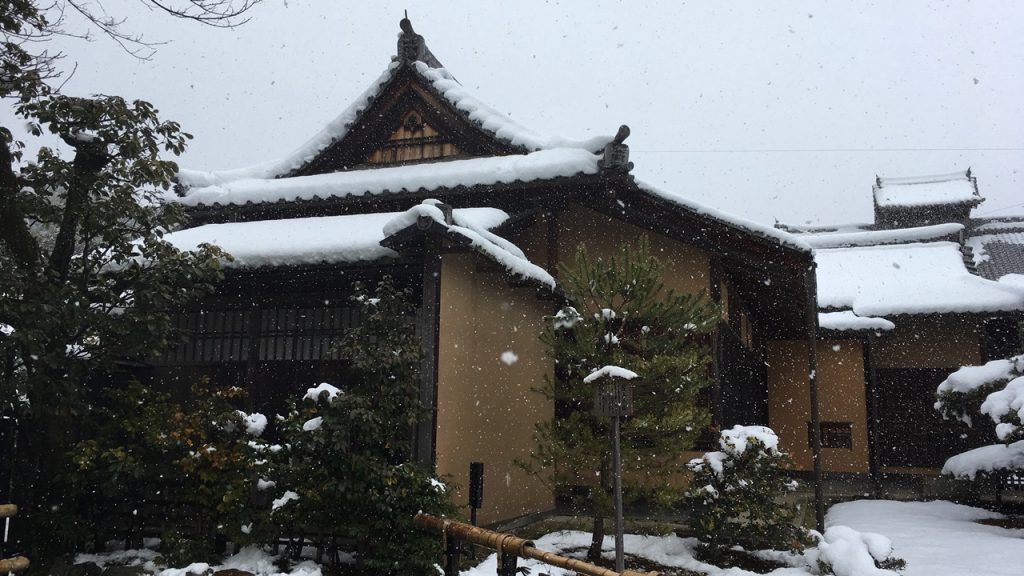
●銀河泉*:Ginga-sen*
This is a spring water called ‘Ginga-sen’.
It is said that Yoshimitsu ASHIKAGA (足利義満) was making japanese green tea with this water.
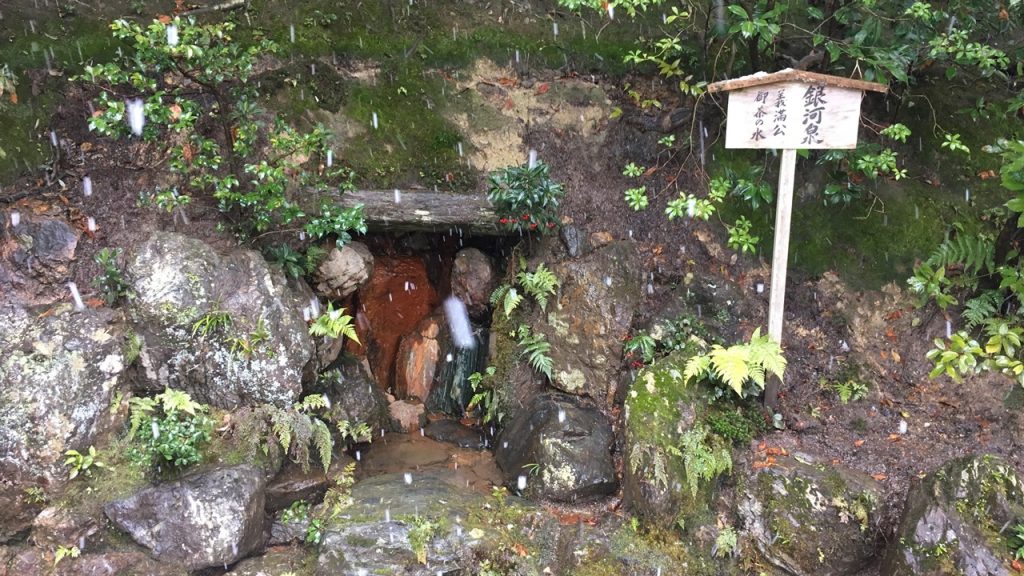
●巌下水*:Ganka-sui*
This is a spring water called ‘Ganka-sui’.
This was water for hand-washing after toilet.
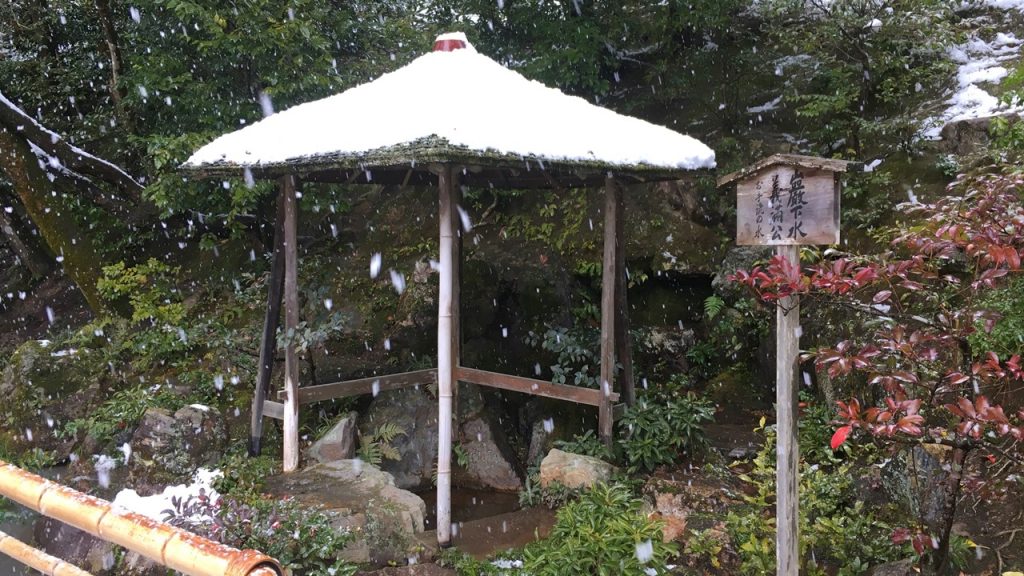
●金閣寺垣*:Kinkaku-ji Gaki (Kinkaku-ji Temple’s fence)*
This is the characteristic fence of this temple called ‘Kinkaku-ji Gaki (Kinkaku-ji Temple’s fence)’.
This fence has a low height than the fence of other temples.

●龍門滝*:Ryumon-no-taki*
This small waterfall is ‘Ryumon-no-taki‘.
There is a following proverb in China.
Gateway to success(登竜門):When a carp climbs the waterfall, it becomes the dragon.
This waterfall is associated with this proverb.
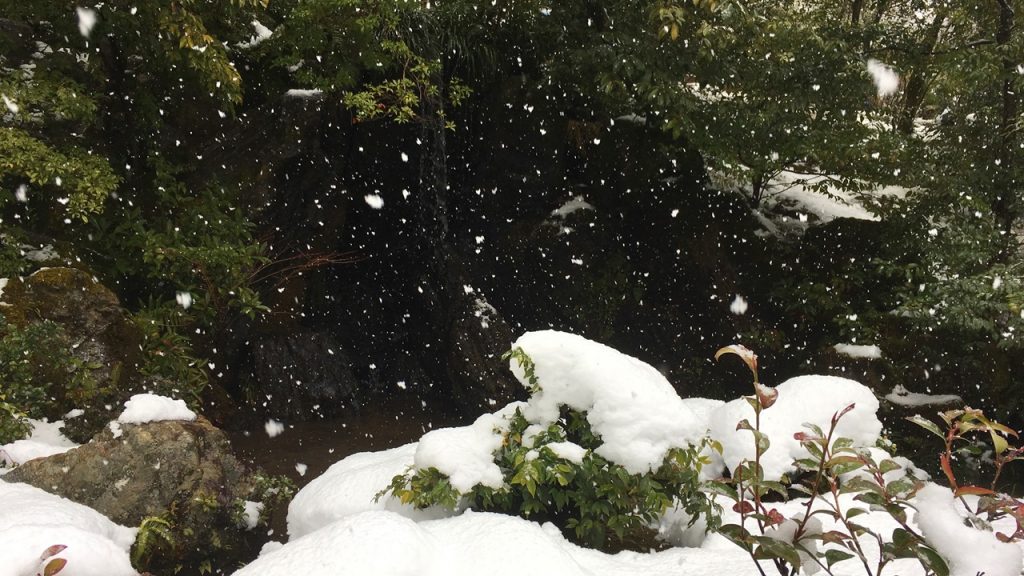
The stone under the waterfall is called Rigyoseki(鯉魚石).
This stone is imagining the carp of the proverb.
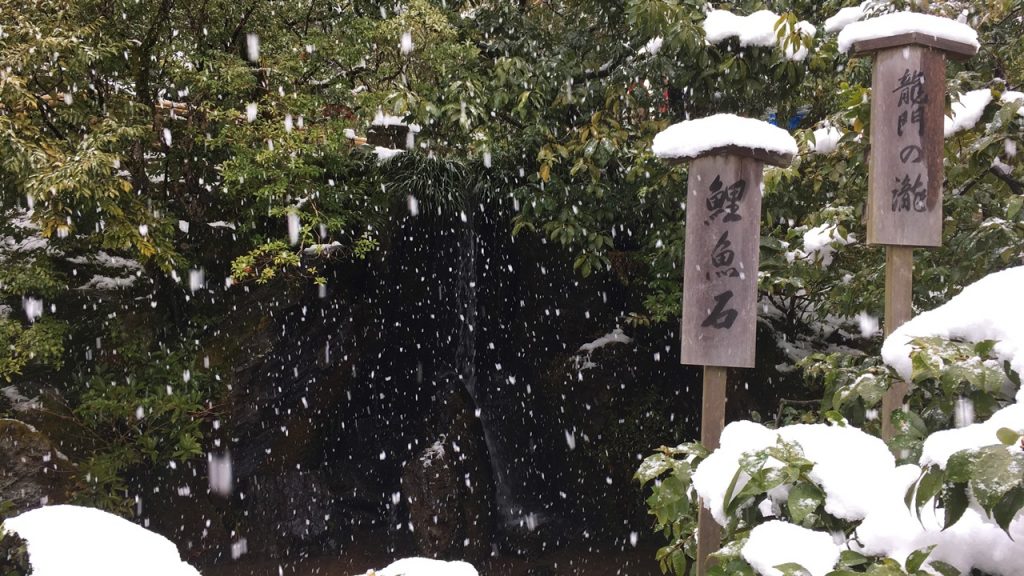
●安民沢*:Anmin-taku Pond*
This is a pond called Anmin-taku Pond.
Because there is this pond in the high place of the north side of the temple, it becomeing the source of a pond of Kyoko-chi Pond.

●白蛇の塚*:Hakuja-no-tsuka (Pagoda of the white snake)*
A pagoda called ‘Hakuja-no-tsuka (Pagoda of the white snake)‘ is built on the island in the middle of this pond.
The white snake is said to be an errand of the Benzaiten (弁財天:Sarasvati).

●夕佳亭*:Sekka-tei*
This is Sekka-tei of the tea house.

This building was built in the Edo period by Shigechika KANAMORI (金森重近) of the master of tea ceremony.

●不動堂*:Fudo-do hall*
This is Fudo-do hall rebuilt in the Azuchi-Momoyama period.
This is the oldest building in this temple.
The stone statue of Fudo Myoo (石不動明王:Acala) which has the divine favor of the health (especially eye diseases) is enshrined in this building.
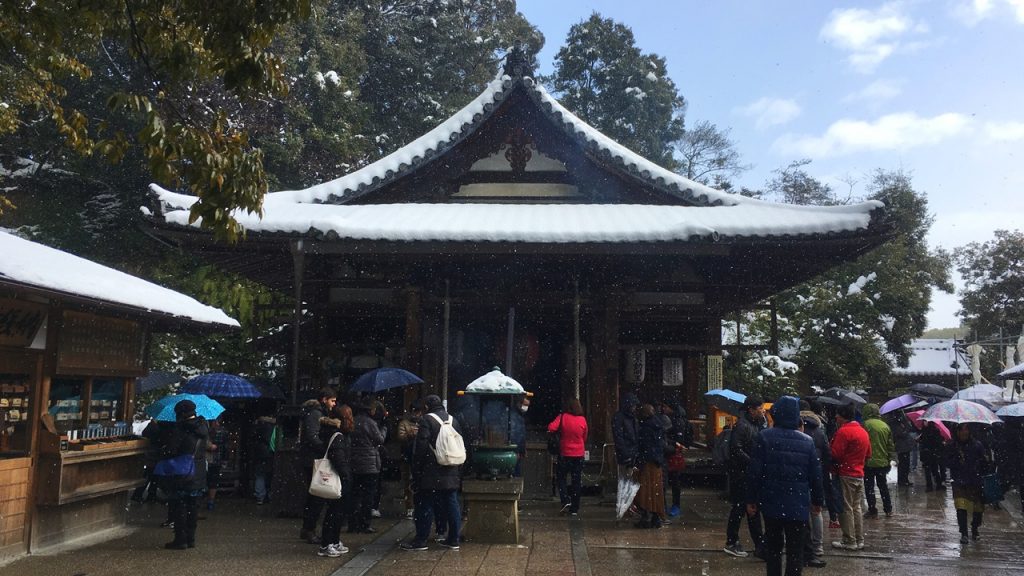
7.Photos of Kinkaku-ji Temple
■Flickr:Photo of Kinkaku-ji Temple (Rokuon-ji Temple) (20170116)
8.Goshuin of Kinkaku-ji Temple
This Temple’s Sumigaki(The words which was written with a sumi(black ink)) is “Shariden(舎利殿)” which is the symbol of this temple.
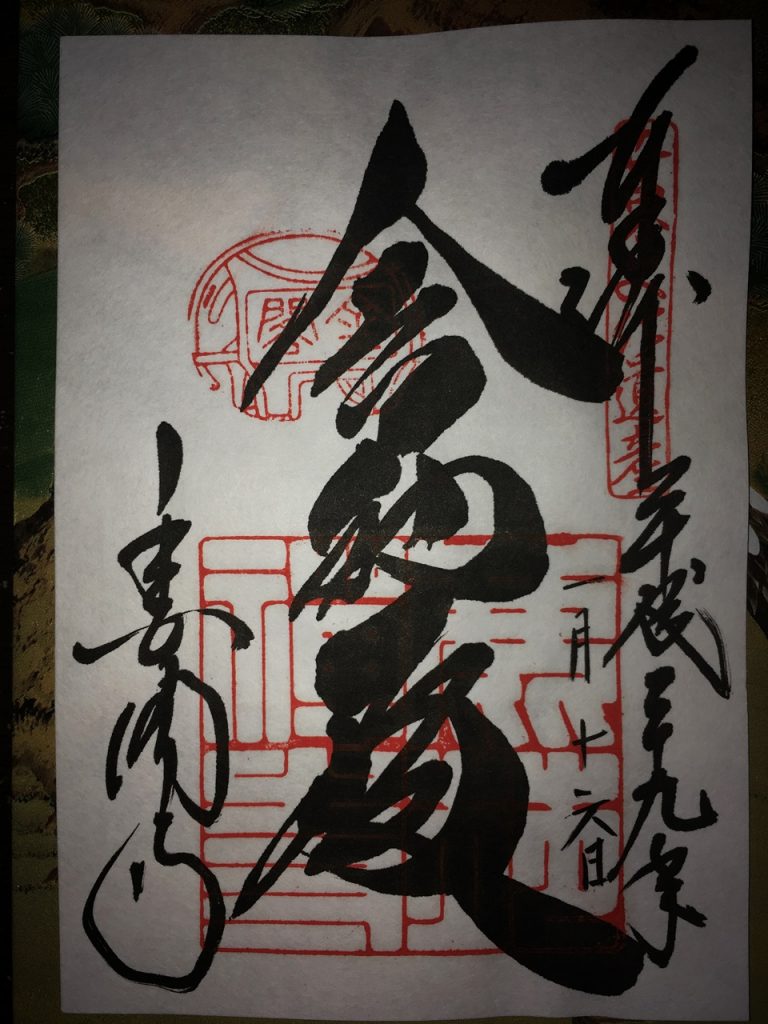
9.How to get to Kinkaku-ji Temple
The nearest station of Kinkaku-ji Temple is ‘Randen Kitano Line Kitano-Hakubaicho Station’.
(We can also go by bus from ‘JR Kyoto Station’, ‘Hankyu Kawaramachi Station’ and ‘Keihan Gion-Shijo Station’.)
Because it is far from the nearest station, I recommend that you use a bus or the taxi.
■Route Example (From Osaka Station to Randen Kitano Line Kitano-Hakubaicho Station)

■Route Example (From Namba Station to Randen Kitano Line Kitano-Hakubaicho Station)
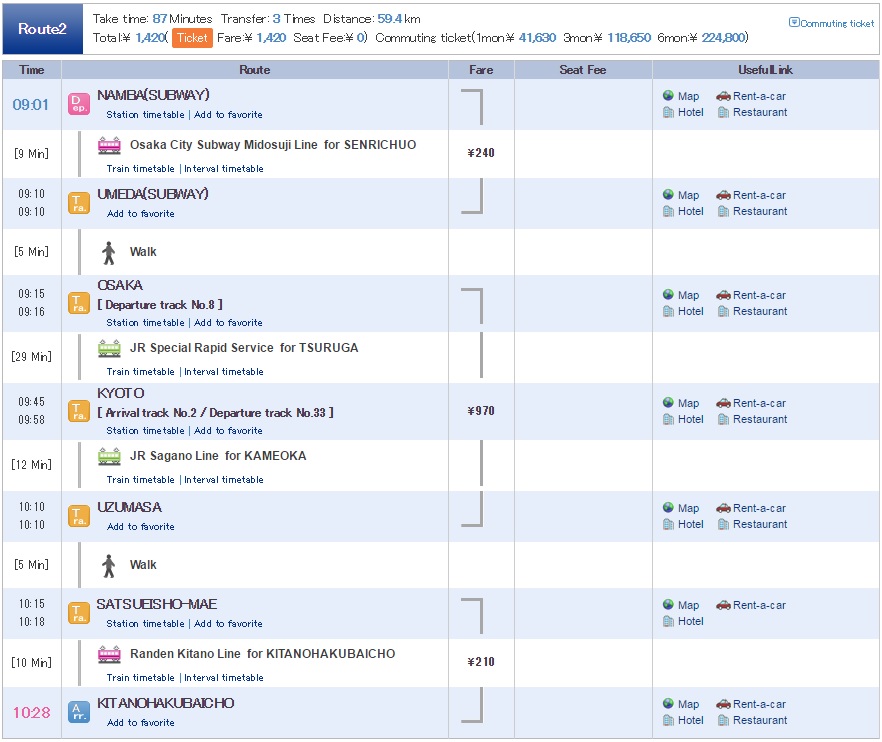
■Route Example (From Kyoto Station to Randen Kitano Line Kitano-Hakubaicho Station)
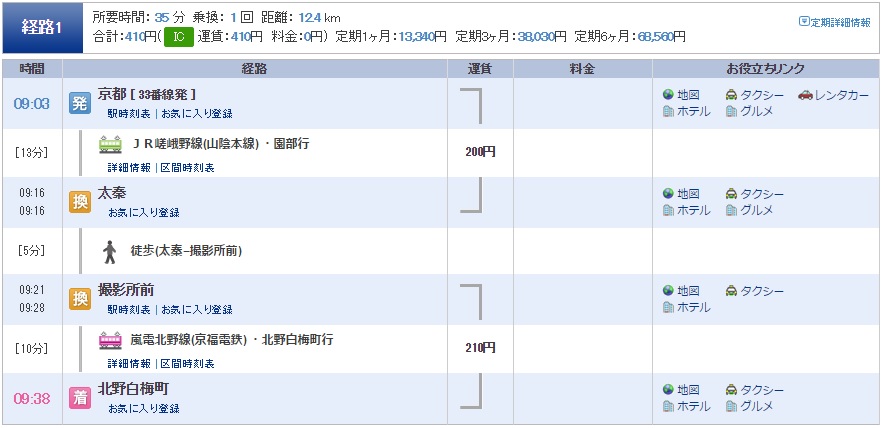
■When you go on foot from Randen Kitano Line Kitano-Hakubaicho Station
It’s about 30 minutes (1.5 km) on foot.
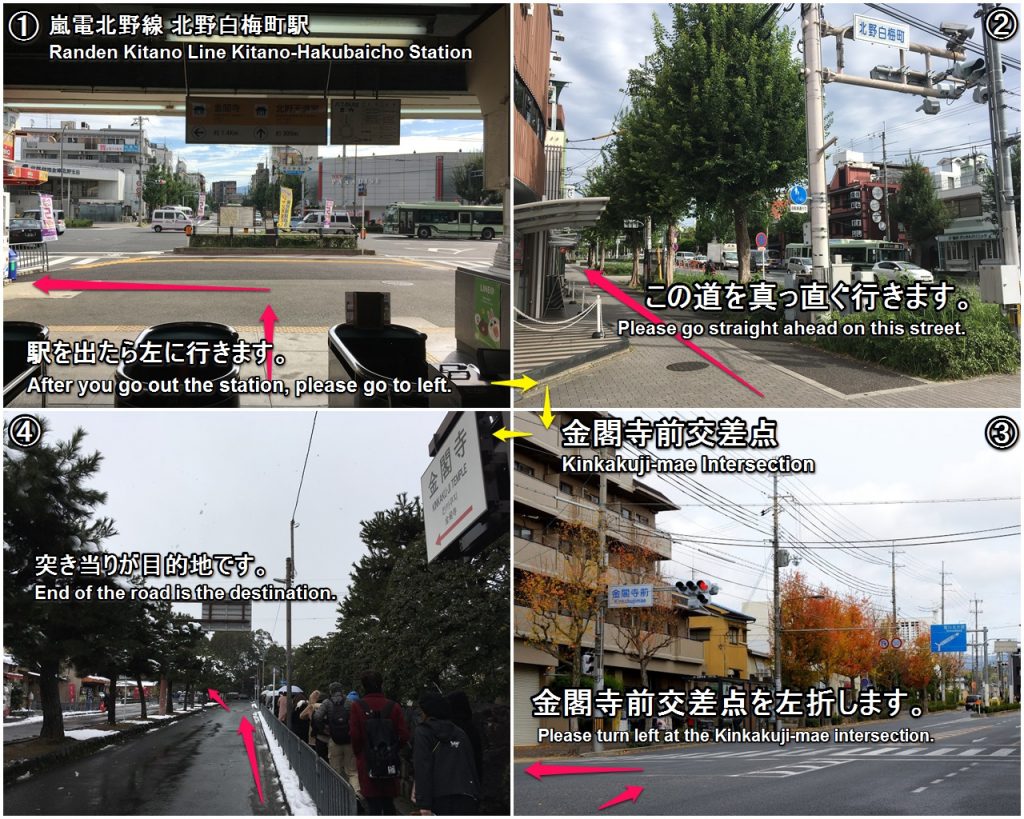
■When you go on foot from Kyoto City Bus Kinkakuji-michi Bus Stop. (Nearest Bus Stop)
It’s about 3 minutes (200 m) on foot.
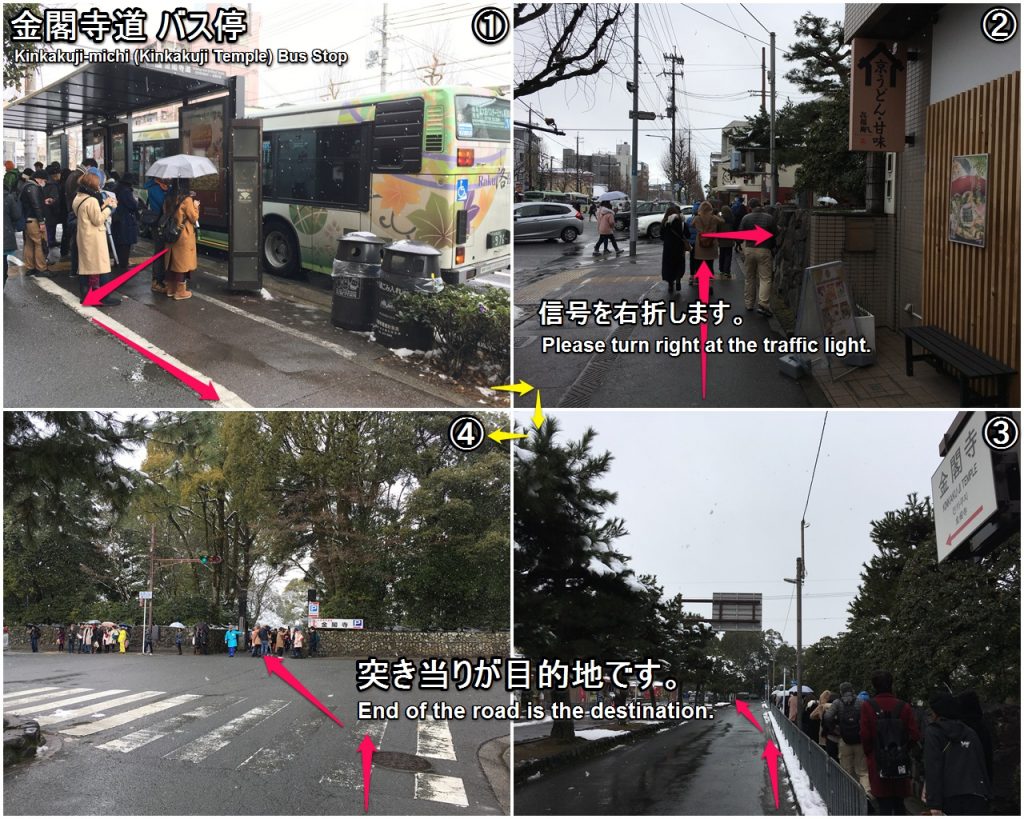
■When you get on a bus from JR Kyoto Station
Timetable and Route Search of bus
■[Platform:B2]
[Timetable]Route No.101
Bus company:Kyoto City Bus
Routes/Destination:No.101[Bound for Kinkakuji Temple Via Nijo-jo Castle]
Boarding bus stop:Kyoto Sta.[B2]
Alighting bus stop:Kinkakuji-michi (Kinkakuji Temple)
Bus fare:230 yen
Time required:About 37 min
■[Platform:B3]
[Timetable]Route No.205
Bus company:Kyoto City Bus
Routes/Destination:No.205[Bound for Kitaoji Bus Terminal Via Kinkakuji Temple]
Boarding bus stop:Kyoto Sta.[B3]
Alighting bus stop:Kinkakuji-michi (Kinkakuji Temple)
Bus fare:230 yen
Time required:About 42 min
■When you get on a bus from Hankyu Kawaramachi Station
Timetable and Route Search of bus
■[Platform:F (Northbound)]
[Timetable]Route No.205
Bus company:Kyoto City Bus
Routes/Destination:No.205[Bound for Kinkakuji Temple]
Boarding bus stop:Shijo Kawaramachi[F]
Alighting bus stop:Kinkakuji-michi (Kinkakuji Temple)
Bus fare:230 yen
Time required:About 37 min
■[Platform:D (Westbound)]
[Timetable]Route No.12
Bus company:Kyoto City Bus
Routes/Destination:No.12[Bound for Kinkakuji Temple]
Boarding bus stop:Shijo Kawaramachi[F]
Alighting bus stop:Kinkakuji-michi (Kinkakuji Temple)
Bus fare:230 yen
Time required:About 36 min
■When you get on a bus from Keihan Gion-Shijo Station
Timetable and Route Search of bus
■[Platform:B]
[Timetable]Route No.12
Bus company:Kyoto City Bus
Routes/Destination:No.12[Bound for Kinkakuji Temple]
Boarding bus stop:Shijo Keihan-mae[B]
Alighting bus stop:Kinkakuji-michi (Kinkakuji Temple)
Bus fare:230 yen
Time required:About 39 min
■[Platform:C]
[Timetable]Route No.59
Bus company:Kyoto City Bus
Routes/Destination:No.59[Bound for Ryoanji Temple Via Kinkakuji Temple]
Boarding bus stop:Shijo Keihan-mae[C]
Alighting bus stop:Kinkakuji-michi (Kinkakuji Temple)
Bus fare:230 yen
Time required:About 39 min
■When you take a taxi
From Kyoto Station:2,930 yen ~ 3,600 yen (about 25 minutes)
From Gion-Shijo Station:2,770 yen ~ 3,360 yen (about 20 minutes)
From Kitano-Hakubaicho Station:690 yen ~ 800 yen (about 20 minutes)
Let’s show a taxi driver the following phrase.
10.Hotel search & reservation around Kinkaku-ji Temple
How did you like it?
Please try to go.
Have a nice trip! XD
<Let’s search the sightseeing information of Kansai in Japan on ‘Japan’s Travel Manual‘!!>
<This site introduces the easiest way to get Japanese (Kansai) sightseeing spots to you.>


